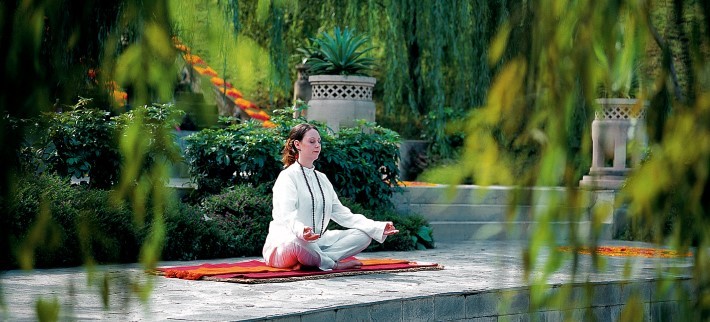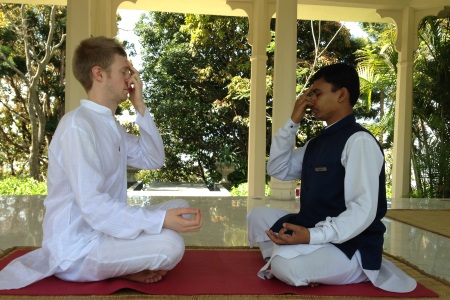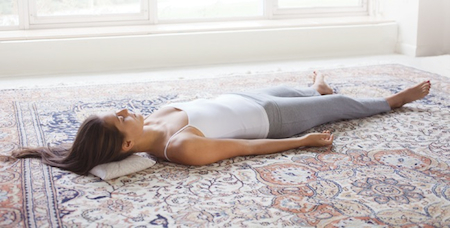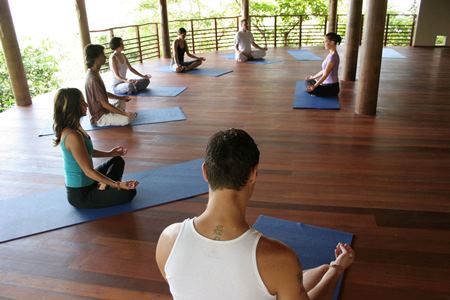Pranayama Breathing: An Introductory Guide

Pranayama is the 'Science of Breath', the control of the vital force (prana) in the air we breathe. It is a meditation technique that consists of slow, regulated deep breathing, which helps to calm the mind, balance the emotions and reduce stress and anxiety. It can be practised anywhere but it is advised that you meditate in a clean, peaceful place. It is most beneficial to do pranayama in the early morning or evening hours and playing appropriate soft music will also enhance your experience.
You can learn the art of Pranayama on one of our luxury yoga holidays, where it is implemented into your programme as a group session or as one-to-one practice. Wellness advisor Smitha Jayakumar from Kamalaya, a wellness sanctuary and holistic spa holiday in Koh Samui, Thailand, explains three methods of Pranayama - beginners, Nadi Shodhana and complete breath, so you can gain a better understanding of Pranayama before your healthy holiday starts.
Beginners Pranayama
A group Pranayama class at Kamalaya in Koh Samui, Thailand
Posture: Sit cross-legged or in any comfortable posture with your back erect.
Procedure: Deep inhalation and exhalation with complete focus on the breath. Inhale, hold your breath and exhale in the given ratio at each stage. Throat breathing is prescribed.
There are 3 stages of pranayama. Each stage has a different hand posture.
Stage 1: tips of index finger and thumb touching each other and keep palms facing downwards on your thigh. Do breathing cycles for 3 - 4 minutes. Ratio 1:2
Stage 2: make a fist of the palm with the thumb folded within and rest on the thigh with fingers facing downwards. Do breathing cycles for 3 - 4 minutes. Ratio 1:1:1
Stage 3: make a fist similar to cycle 2 and hold together at the navel with fingers facing upwards. Do breathing cycles for 3 - 4 minutes. Ratio 1:1:2
Nadi Shodhana Pranayama

Our Travel Specialist Adam practising Pranayama at Ananda in India
The purpose of this exercise is to purify and strengthen the nervous system. It also helps to heal lung problems, hypertension and asthma.
Posture: Sit in any comfortable posture. Breathe normally. Keep your eyes closed.
Stage 1: Close your right nostril with your thumb and breathe in through the left nostril. Now close the left nostril with your ring finger and keep the air in for a few seconds. Then lift the thumb from the right nostril and exhale slowly, keeping the left nostril closed. This is one cycle of breathing. Continue the cycle for 3 to 4 minutes.
Stage 2: Reverse the process of breathing, by inhaling through the right nostril and exhaling through the left nostril. Continue the cycle for 3 to 4 minutes.
Stage 3: In the first part of the cycle, inhale through the right nostril and exhale through the left nostril. In the second part of the cycle, inhale through the left nostril and exhale through the right nostril. Both parts together make one cycle of breathing. Continue the cycle for 3 to 4 minutes.
Please be aware that beginners could feel slightly light headed as they do this exercise. Just lie down on your back for a few minutes and relax.
Complete Breath Pranayama

Complete Breath Pranayama being practised at home
Using the ancient Dirga Pranayama, this takes you into deeper states of relaxation and calmness, brings your focus to the present and grounds the mind.
Posture: Lie down flat on your back with your arms by the sides. Please keep eyes closed and relax your body and face.
Procedure: Begin by observing the natural inhalation and exhalation of your breath without changing anything. Then begin to inhale deeply through the nose.
On each inhale, fill the belly up with your breath. Expand the belly with air like a balloon. On each exhale, expel all the air out from the belly through your nose. Draw the navel back towards your spine to make sure that the belly is empty of air. Repeat this deep belly breathing for about five breaths.
On the next inhale, fill the belly up with air as described above. Then when the belly is full, draw in a little more breath and let that air expand into the rib cage causing the ribs to widen apart.
On the exhale, let the air go first from the rib cage, letting the ribs slide closer together, and them from the belly, drawing the navel back towards the spine. Repeat this deep breathing into the belly and rib cage for about 5 breaths.
On the next inhale, fill the belly and rib cage up with air as described above. Then draw in just a little more air and let it fill the upper chest, all the way up to the collarbone, causing the area around the heart (which is called the heart center in yoga), expand and rise.
On the exhale, let the breath go first from the upper chest, allowing the heart centre sink back down, then from the rib cage, letting the ribs slide closer together. Finally, let the air go from the belly, drawing the navel back towards the spine. Continue for about 10 breaths.
Talk to one of our Travel Specialists on 0203 397 8891 or contact us here to discuss tailor-making your perfect healthy holiday.


